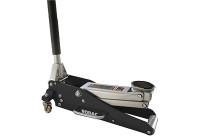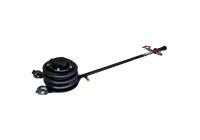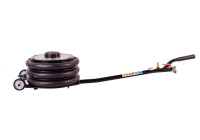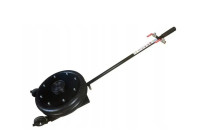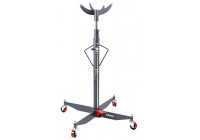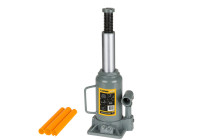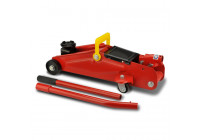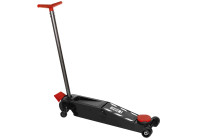Bottle & car jack
A car jack or trolley jack is a handy tool to lift the car off the ground. Doing jobs on the car such as changing tyres or
replacing brake pads and brake discs, jacking up the car is necessary. This is where
you use a car jack. However, safety when using a trolley jack or any other kind
of car jack is very important. It is important that you purchase a high-quality
and robust jack. We advise against saving and buying a cheap car jack. There
are different types of car jacks such as; scissor jack, hydraulic trolley jack
and bottle jack. We explain these different types below.
Types of
car jacks A scissor
jack is a jack that you raise with a swivel arm. Scissor jacks often have a
lifting capacity between 1 and 2 ton. A scissor jack is fairly light and
therefore more convenient than a hydraulic jack. It’s also easy to carry in the
boot of the car. In addition, scissor jacks are also known for safety when
jacking up. However, a disadvantage is that these scissor jacks are somewhat
more unstable than, for example, a hydraulic trolley jack. Also, jacking up a
car still costs quite a bit of power. A scissor jack is often seen as
"emergency aid" to quickly change a tyre on the way. For larger jobs,
it is wiser to use a hydraulic jack, these are just a bit more sturdy and offer
more safety.
We have just mentioned it a few times, the hydraulic trolley jack. The
hydraulic jack is more versatile than, for example, a scissor jack. The lifting
capacity of a hydraulic trolley jack is often more than 2 tons. In addition,
they are also just a bit stronger and therefore safer than a scissor jack. It
also requires less force to lift the car with a hydraulic jack. The car is
completely raised within a few pumps. A disadvantage compared to the scissor
jack is that a hydraulic jack is a lot heavier and bigger. You won’t be able to
carry it in the boot without sacrificing boot space.
In addition, there is also a bottle
jack. A bottle jack is often a hydraulic jack, but without wheels. The lifting
capacity is also equal to that of a hydraulic trolley jack, so at least 2 tons.
A pot jack, on the other hand, is lighter and more compact than a hydraulic car
jack and therefore easier to carry. In addition, they are also very easy to
operate. A disadvantage of a pot jack, however, is that thanks to its shape,
they can topple somewhat more easily, in contrast to a roll jack. In terms of
safety, the bottle jack is therefore slightly less advisable.
What car
jack do I need? Before you
purchase a garage jack or car jack, you naturally want to know what you need.
There are a few points you can pay attention to. First of all, the weight of
your car is important. Every car has a certain weight, but every car jack also
has a maximum lifting capacity. So for a lighter car, you need a garage jack
with less power than for a heavier car. However, a car jack with a lifting
capacity of 2 tonnes is sufficient for most cars. It’s better to have a jack
with much more capacity than needed, because it will be safer lifting the lower
than specified max lifting weight. Another point to pay attention to is the
minimum and maximum height of the car jack. Not every jack fits under all cars.
If your car is lowered, you need a low jack. For a high car, it is important
that the jack can be high enough to lift the car with the wheels off the
ground.
Buy a car jack Buying a
car jack is quick and easy at Winparts. With us, you will find a wide range of
car jacks from different types and brands. You can also turn to Winparts for
other tools such as a tyre pump, spray lubrication or siphon pumps.
